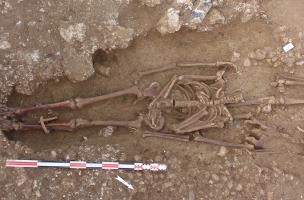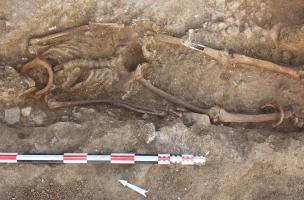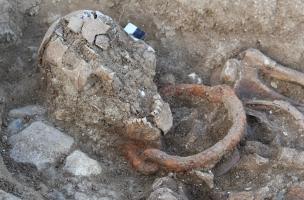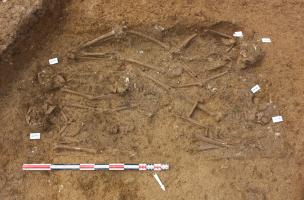You are here
An Antique necropolis in the western peripheral quarter of the city of Saintes: several shackled individuals, including one child
From September to November 2014, a team of Inrap archaeologists conducted a rescue excavation, under prescription of the State (Drac Poitou-Charentes), on a 613 m2 parcel in advance of the construction of a single-family home in the western quarter of Saintes.
A prior excavation realized in 2013 on a contiguous parcel revealed the funerary vocation of this space during Antiquity. This year’s operation resulted in the discovery of around one hundred burials.
A large Gallo-Roman necropolis
The excavation revealed several double burials: the individuals were placed next to each other in a “head to tails” position (the head of one next to the feet of the other), in a long, rectangular pit, resembling a trench, with each one deposited at one of the extremities of the pit. A pit with a multiple burial was also uncovered during the last days of the excavation. It measures 2 by 1.3 meters and contains five individuals, including two children and two young women.
An absence of funerary objects
Shackled individuals
The archaeologists identified several shackled individuals among the deceased. Four of them are adults (three men and a one undetermined specimen) wearing shackles. The shackles were hot riveted onto the left ankle of three of the individuals. The fourth was buried with a different type of shackle, consisting of a slave collar, or carcan. The incomplete skeleton of a child also had a shackle on its left wrist. This object, more rudimentary than the others, is characterized by a flat and curved main piece with an irregular shape and riveted extremities. A ring with a circular shape and section is also present.
Though shackles have been discovered before, particularly in Saintes, this excavation revealed a group of graves containing shackled individuals. It also yielded a complete corpus and showed that a single individual could be constrained with several devices at once. The archaeologists are now investigating the status of these individuals, their origin and the nature of their death. In future laboratory studies involving physical anthropological analyses, they will also attempt to determine if the other inhumed individuals shared similar living conditions and belonged to the same community.

Burial 2055.
Male individual inhumed horizontally with an iron shackle on his lower left leg.
© Frédéric Méténier, Inrap 2014.

Burial 2073.
Male individual buried horizontally with a shackle on his neck and right ankle.
© Frédéric Méténier, Inrap 2014.

Close-up of burial 2073.
© Frédéric Méténier, Inrap 2014.

Complete view of multiple burial 2094, in the process of excavation.
© Frédéric Méténier, Inrap 2014.
Coralie Roumagne
Cultural development and communication
Inrap, direction interrégionale Grand Sud-Ouest
05 57 59 21 09
coralie.roumagne [at] inrap.fr

